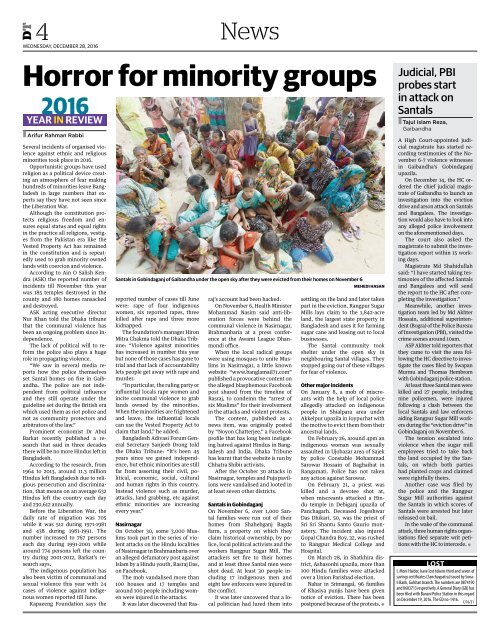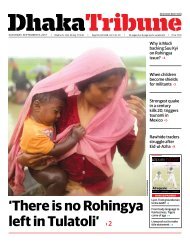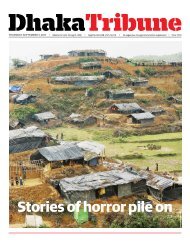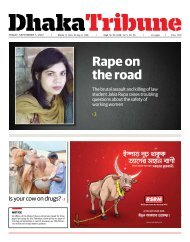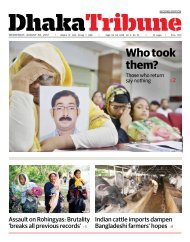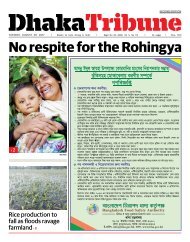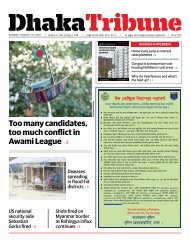e_Paper_Wednesday_December 12, 2016
Create successful ePaper yourself
Turn your PDF publications into a flip-book with our unique Google optimized e-Paper software.
4<br />
WEDNESDAY, DECEMBER 28, <strong>2016</strong><br />
DT<br />
News<br />
Horror for minority groups<br />
<strong>2016</strong><br />
YEAR IN REVIEW<br />
• Arifur Rahman Rabbi<br />
Several incidents of organised violence<br />
against ethnic and religious<br />
minorities took place in <strong>2016</strong>.<br />
Opportunistic groups have used<br />
religion as a political device creating<br />
an atmosphere of fear making<br />
hundreds of minorities leave Bangladesh<br />
in large numbers that experts<br />
say they have not seen since<br />
the Liberation War.<br />
Although the constitution protects<br />
religious freedom and ensures<br />
equal status and equal rights<br />
in the practice all religions, vestiges<br />
from the Pakistan era like the<br />
Vested Property Act has remained<br />
in the constitution and is repeatedly<br />
used to grab minority owned<br />
lands with coercion and violence.<br />
According to Ain O Salish Kendra<br />
(ASK) the reported number of<br />
incidents till November this year<br />
was 185 temples destroyed in the<br />
county and 180 homes ransacked<br />
and destroyed.<br />
ASK acting executive director<br />
Nur Khan told the Dhaka tribune<br />
that the communal violence has<br />
been an ongoing problem since Independence.<br />
The lack of political will to reform<br />
the police also plays a huge<br />
role in propagating violence.<br />
“We saw in several media reports<br />
how the police themselves<br />
set Santal homes on fire in Gaibandha.<br />
The police are not independent<br />
from political influence<br />
and they still operate under the<br />
guideline set during the British era<br />
which used them as riot police and<br />
not as community protectors and<br />
arbitrators of the law.”<br />
Prominent economist Dr Abul<br />
Barkat recently published a research<br />
that said in three decades<br />
there will be no more Hindus left in<br />
Bangladesh.<br />
According to the research, from<br />
1964 to 2013, around 11.3 million<br />
Hindus left Bangladesh due to religious<br />
persecution and discrimination,<br />
that means on an average 632<br />
Hindus left the country each day<br />
and 230,6<strong>12</strong> annually.<br />
Before the Liberation War, the<br />
daily rate of migration was 705<br />
while it was 5<strong>12</strong> during 1971-1981<br />
and 438 during 1981-1991. The<br />
number increased to 767 persons<br />
each day during 1991-2001 while<br />
around 774 persons left the country<br />
during 2001-20<strong>12</strong>, Barkat’s research<br />
says.<br />
The indigenous population has<br />
also been victim of communal and<br />
sexual violence this year with 24<br />
cases of violence against indigenous<br />
women reported till June.<br />
Kapaeeng Foundation says the<br />
Santals in Gobindaganj of Gaibandha under the open sky after they were evicted from their homes on November 6<br />
MEHEDI HASAN<br />
reported number of cases till June<br />
were: rape of four indigenous<br />
women, six reported rapes, three<br />
killed after rape and three more<br />
kidnapped.<br />
The foundation’s manager Hiron<br />
Mitra Chakma told the Dhaka Tribune:<br />
“Violence against minorities<br />
has increased in number this year<br />
but none of those cases has gone to<br />
trial and that lack of accountability<br />
lets people get away with rape and<br />
murder.<br />
“In particular, the ruling party or<br />
influential locals rape women and<br />
incite communal violence to grab<br />
lands owned by the minorities.<br />
When the minorities are frightened<br />
and leave, the influential locals<br />
can use the Vested Property Act to<br />
claim that land,” he added.<br />
Bangladesh Adivasi Forum General<br />
Secretary Sanjeeb Drong told<br />
the Dhaka Tribune: “It’s been 45<br />
years since we gained independence,<br />
but ethnic minorities are still<br />
far from asserting their civil, political,<br />
economic, social, cultural<br />
and human rights in this country.<br />
Instead violence such as murder,<br />
attacks, land grabbing, etc against<br />
ethnic minorities are increasing<br />
every year.”<br />
Nasirnagar<br />
On October 30, some 3,000 Muslims<br />
took part in the series of violent<br />
attacks on the Hindu localities<br />
of Nasirnagar in Brahmanbaria over<br />
an alleged defamatory post against<br />
Islam by a Hindu youth, Rasraj Das,<br />
on Facebook.<br />
The mob vandalised more than<br />
100 houses and 17 temples and<br />
around 100 people including women<br />
were injured in the attacks.<br />
It was later discovered that Rasraj’s<br />
account had been hacked.<br />
On November 6, Health Minister<br />
Mohammad Nasim said anti-liberation<br />
forces were behind the<br />
communal violence in Nasirnagar,<br />
Brahmanbaria at a press conference<br />
at the Awami League Dhanmondi<br />
office.<br />
When the local radical groups<br />
were using mosques to unite Muslims<br />
in Nasirnagar, a little known<br />
website “www.banglamail71.com”<br />
published a provocative content on<br />
the alleged blasphemous Facebook<br />
post shared from the timeline of<br />
Rasraj, to condemn the “arrest of<br />
six Muslims” for their involvement<br />
in the attacks and violent protests.<br />
The content, published as a<br />
news item, was originally posted<br />
by “Noyon Chatterjee,” a Facebook<br />
profile that has long been instigating<br />
hatred against Hindus in Bangladesh<br />
and India. Dhaka Tribune<br />
has learnt that the website is run by<br />
Chhatra Shibir activists.<br />
After the October 30 attacks in<br />
Nasirnagar, temples and Puja pavilions<br />
were vandalised and looted in<br />
at least seven other districts.<br />
Santals in Gobindaganj<br />
On November 6, over 1,000 Santal<br />
families were run out of their<br />
homes from Shahebganj Bagda<br />
farm, a property on which they<br />
claim historical ownership, by police,<br />
local political activists and the<br />
workers Rangpur Sugar Mill. The<br />
attackers set fire to their homes<br />
and at least three Santal men were<br />
shot dead. At least 30 people including<br />
17 indigenous men and<br />
eight law enforcers were injured in<br />
the conflict.<br />
It was later uncovered that a local<br />
politician had lured them into<br />
settling on the land and later taken<br />
part in the eviction. Rangpur Sugar<br />
Mills lays claim to the 1,842-acre<br />
land, the largest state property in<br />
Bangladesh and uses it for farming<br />
sugar cane and leasing out to local<br />
businesses.<br />
The Santal community took<br />
shelter under the open sky in<br />
neighbouring Santal villages. They<br />
stopped going out of these villages<br />
for fear of violence.<br />
Other major incidents<br />
On January 8, a mob of miscreants<br />
with the help of local police<br />
allegedly attacked on indigenous<br />
people in Shialpara area under<br />
Akkelpur upazila in Joypurhat with<br />
the motive to evict them from their<br />
ancestral lands.<br />
On February 26, around 4pm an<br />
indigenous woman was sexually<br />
assaulted in Ujobazar area of Sajek<br />
by police Constable Mohammad<br />
Sarowar Hossain of Baghaihat in<br />
Rangamati. Police has not taken<br />
any action against Sarowar.<br />
On February 21, a priest was<br />
killed and a devotee shot at,<br />
when miscreants attacked a Hindu<br />
temple in Debiganj upazila of<br />
Panchagarh. Deceased Jogeshwar<br />
Das Dhikari, 50, was the priest of<br />
Sri Sri Shantu Santo Gaurio monastery.<br />
The incident also injured<br />
Gopal Chandra Roy, 32, was rushed<br />
to Rangpur Medical College and<br />
Hospital.<br />
On March 28, in Shatkhira district,<br />
Ashasonhi upazila, more than<br />
100 Hindu families were attacked<br />
over a Union Parishad election.<br />
Nahar in Srimangal, 96 families<br />
of Khasiya punjis have been given<br />
notice of eviction. There has been<br />
postponed because of the protests. •<br />
Judicial, PBI<br />
probes start<br />
in attack on<br />
Santals<br />
• Tajul Islam Reza,<br />
Gaibandha<br />
A High Court-appointed judicial<br />
magistrate has started recording<br />
testimonies of the November<br />
6-7 violence witnesses<br />
in Gaibandha’s Gobindaganj<br />
upazila.<br />
On <strong>December</strong> 14, the HC ordered<br />
the chief judicial magistrate<br />
of Gaibandha to launch an<br />
investigation into the eviction<br />
drive and arson attack on Santals<br />
and Bangalees. The investigation<br />
would also have to look into<br />
any alleged police involvement<br />
on the aforementioned days.<br />
The court also asked the<br />
magistrate to submit the investigation<br />
report within 15 working<br />
days.<br />
Magistrate Md Shahidullah<br />
said: “I have started taking testimonies<br />
of the affected Santals<br />
and Bangalees and will send<br />
the report to the HC after completing<br />
the investigation.”<br />
Meanwhile, another investigation<br />
team led by Md Akhter<br />
Hossain, additional superintendent<br />
(Bogra) of the Police Bureau<br />
of Investigation (PBI), visited the<br />
crime scenes around 10am.<br />
ASP Akhter told reporters that<br />
they came to visit the area following<br />
the HC directive to investigate<br />
the cases filed by Swapan<br />
Murmu and Thomas Hembrom<br />
with Gobindaganj police station.<br />
At least three Santal men were<br />
killed and 27 people, including<br />
nine policemen, were injured<br />
following a clash between the<br />
local Santals and law enforcers<br />
aiding Rangpur Sugar Mill workers<br />
during the “eviction drive” in<br />
Gobindaganj on November 6.<br />
The tension escalated into<br />
violence when the sugar mill<br />
employees tried to take back<br />
the land occupied by the Santals,<br />
on which both parties<br />
had planted crops and claimed<br />
were rightfully theirs.<br />
Another case was filed by<br />
the police and the Rangpur<br />
Sugar Mill authorities against<br />
the Santals in which scores of<br />
Santals were arrested but later<br />
released on bail.<br />
In the wake of the communal<br />
attack, three human rights organisations<br />
filed separate writ petitions<br />
with the HC to intercede. •


